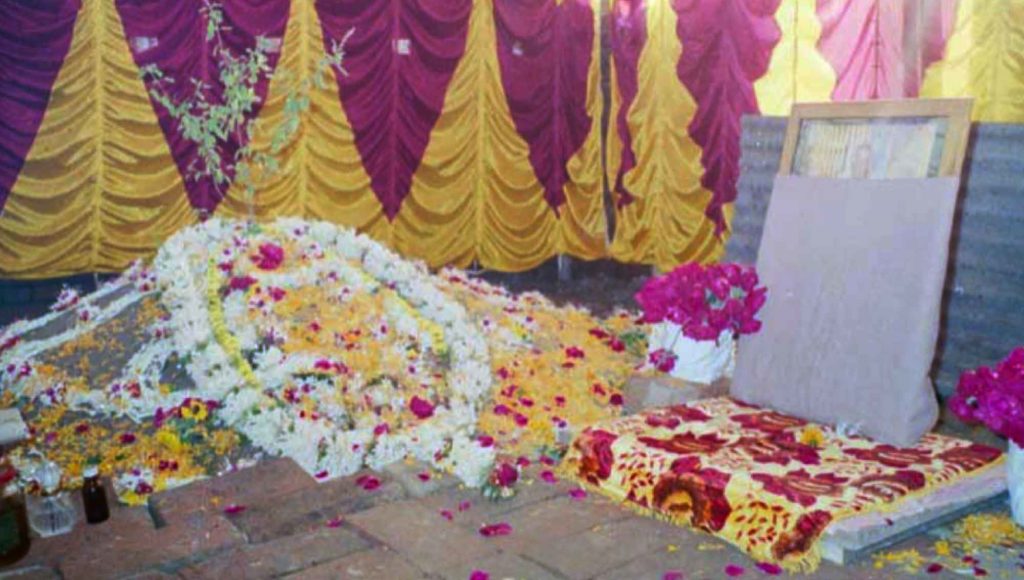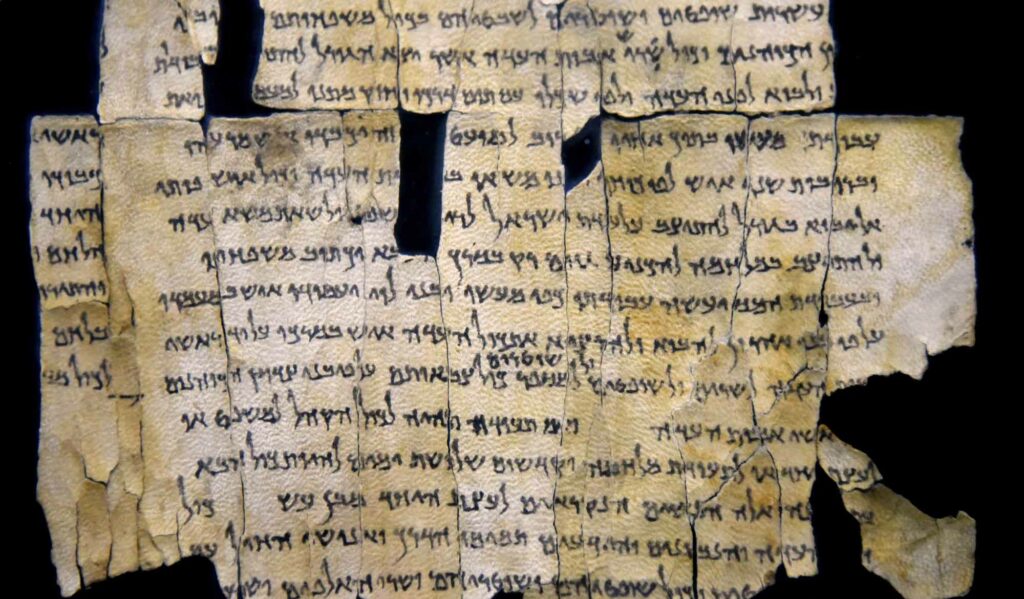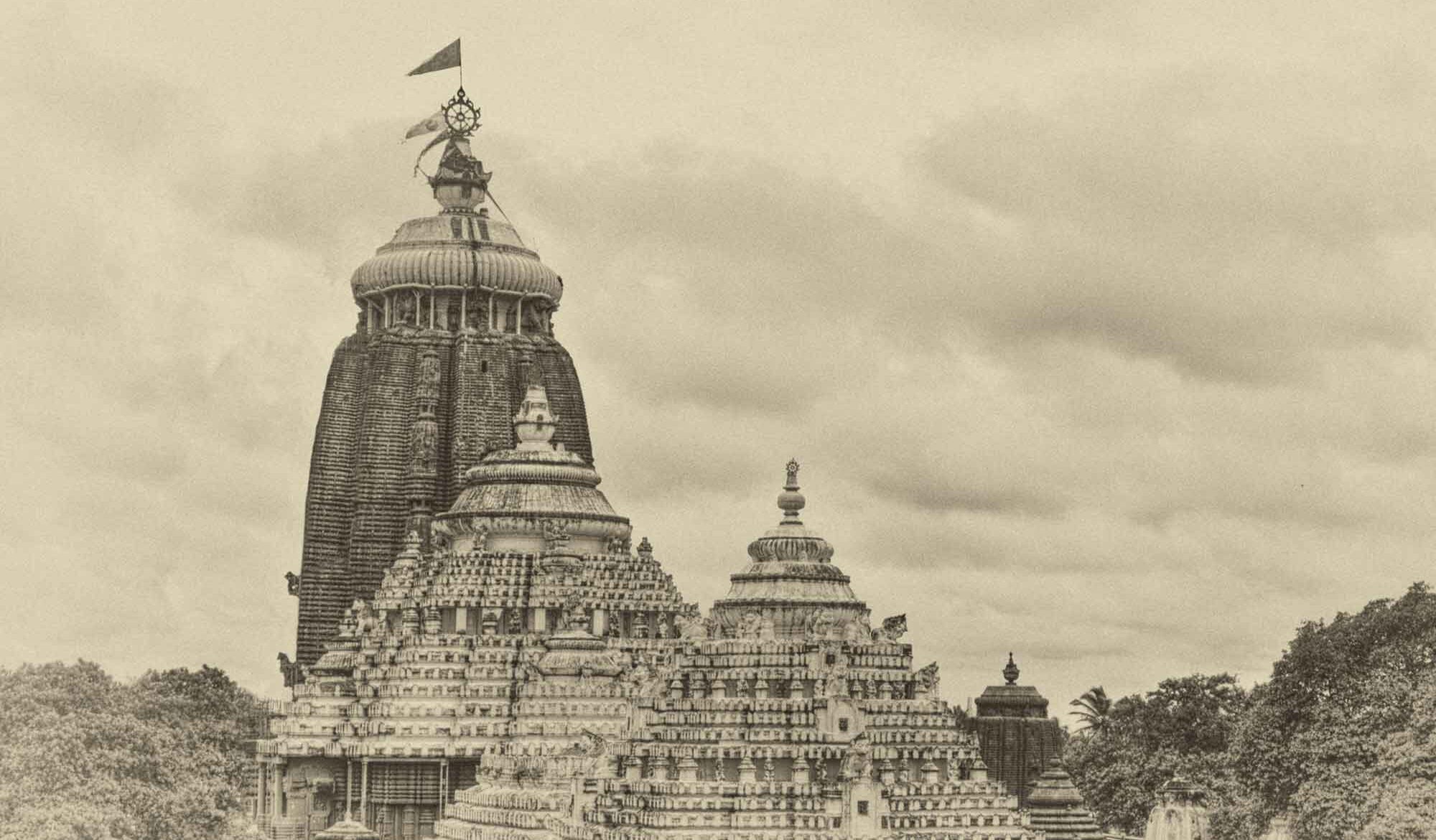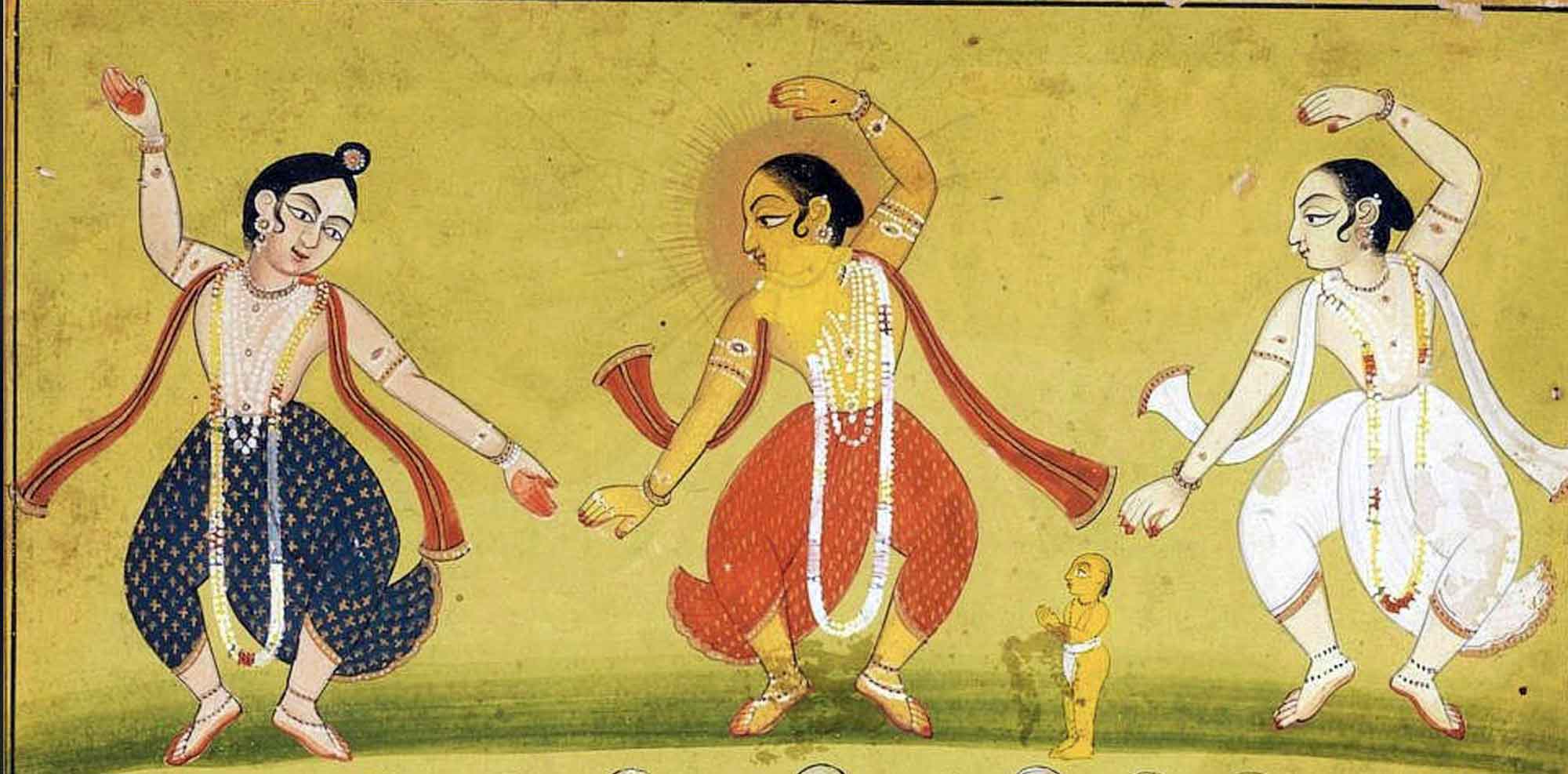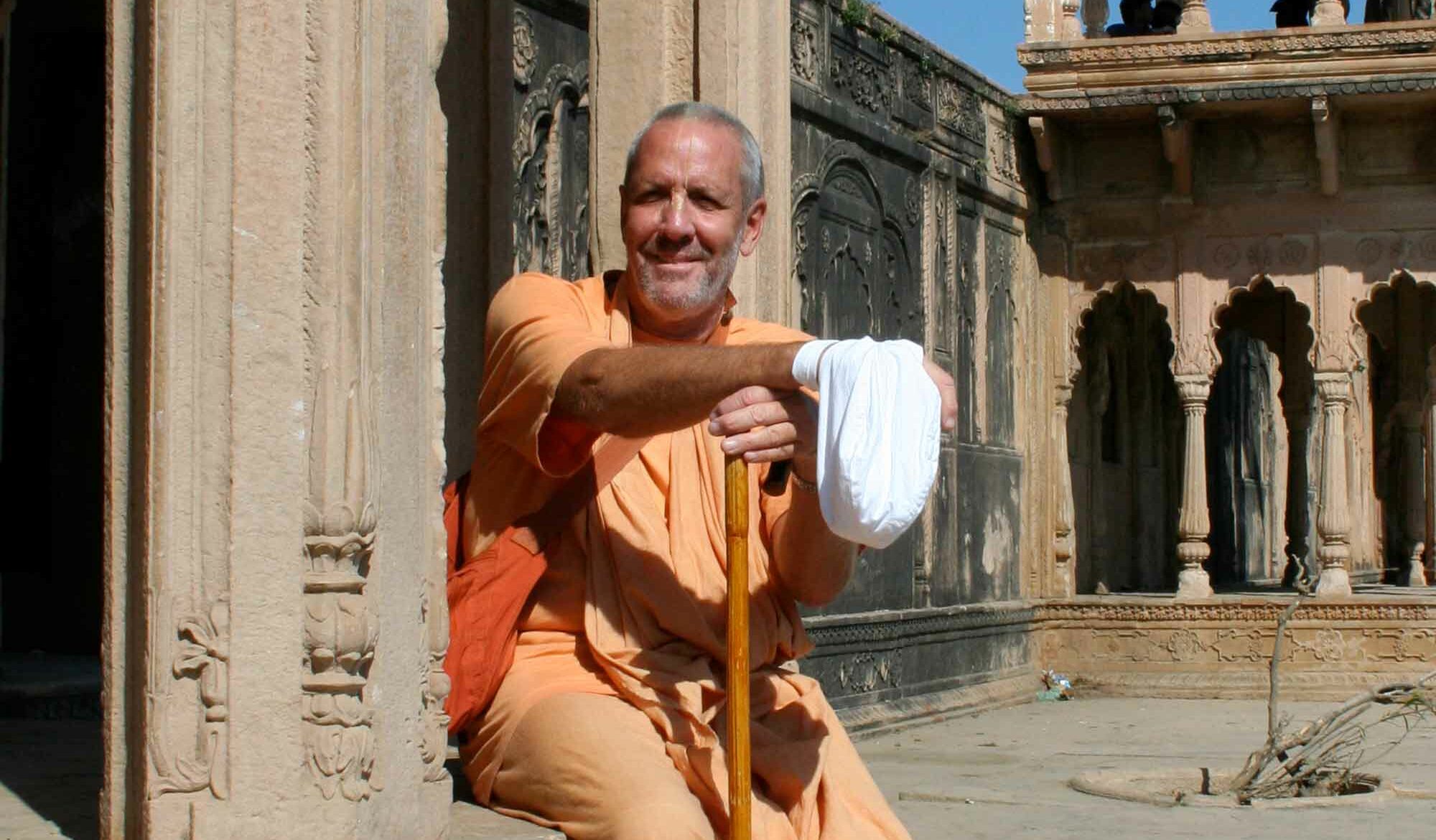by Swami B.G. Narasingha
“Jaipur” was written by Śrīla B.G. Narasiṅgha Mahārāja for ‘Clarion Call’ magazine, Vol.1, issue 2 in 1988. Mahārāja gives a history of Jaipur and in particular, talks about the famous Deity of Govindaji, who resides within the heart of the Pink City.
“…a city where every public building was designed in harmony…so that every resident would have clear and easy access to the beauties and energies of nature.”
Amongst the modern cities of the world in spite of technological achievements there prevails a discontent. The call for “appropriate technology” often finds the thinkers of the day looking to civilizations of the past many of whose cities were far from primitive. However, their technological achievements were not an arrogant challenge to nature rather an embracing of nature, a commitment to work with nature in affirming the beauty and wisdom of the creation. Swami Narasingha’s continuing journey in search of our planet’s spiritual heritage brought him to India’s, desert, Rajasthan, where he found the oasis of Jaipur, the city of victory. There appropriate technology and God centred living have made this city’s history worth hearing and its people worth visiting.
Jaipur is a vibrant symbol of all that was once the glory of India; nobility, wealth, culture, learning and religion. It is certainly distinct among the great cities of the East. Famous for many things, stately grandeur, lavish architecture, classical music, paintings, jewellery, and temples, Jaipur is known best for its God centred people whose enthusiastic spirit turns every day into a festival of life.
The end of the 17th century witnessed an especially ugly reign of terror in India, the reign of Aurangzeb. The cruel Emperor spared no one who refused to embrace Islam. He sent his armies far and wide with the Koran in one hand and the sword in the other. Hundreds and thousands of innocent people were put to death and smouldering farms and villages were all that remained in his wake. The unspeakable atrocities performed by Aurangzeb have earned him an infamous position in the history of India.
The palace at Amber in Rajaputan or Rajasthan posed routine resistance to Aurangzeb. But with the untimely death of their king, Raja Bishan Singh, in 1700, there came difficult times of uncertainty. Jai Singh III, ascended the throne of his late father at the tender age of thirteen. Although merely a child, young Jai Singh would have to face the aging and intolerant Aurangzeb.
When the young prince and his attendants came to the Imperial Court in Delhi, Aurangzeb immediately shouted, “Your ancestors gave me much trouble. I trust you will not do the same.” Then, Aurangzeb tightly clutched the boy’s hands and in a bullying tone said, “And what use are these little arms now?”
Young Jai Singh looked straight into the eyes of the frenzied Emperor and replied, “Your highness, when a bridegroom takes his bride’s hand in marriage he is duty bound to protect her for life. If the Emperor of India has taken both of my hands in his, what have I to fear? I need no other arms than thine.” The Emperor was pacified by the young boy’s affectionate response and everyone in the court breathed a sigh of relief.
A mediocre relationship between the Imperial Court and Amber existed for some years until Jai Singh’s ministers discovered Aurangzeb’s plan to destroy the magnificent Govinda Temple in Vrindavana. Jai Singh’s forefathers had, for generation after generation, travelled to the holy place of Vrindavana to worship Krishna (Govinda). In fact, it was Jai Singh’s grandfather, Man Singh, who had financed the building of the Govinda Temple.
It was more than Jai Singh could stomach. How could he stand by and let the place most sacred to his family be destroyed? But what could he, a nineteen-year-old prince, do against the powerful Emperor? In an angry mood, Jai Singh rode on horseback 294 kilometers to Vrindavana in an attempt to save the temple. With the armies of Aurangzeb not far behind there was scarcely time to warn the people and to rescue the Deity of Govinda. Jai Singh concealed the Deity in an ox-drawn cart and returned to his palace at Amber undetected.
When the armies of Aurangzeb arrived they found their plans had been foiled. The Emperor was furious. Nothing could stop his destructive rage. With thousands of soldiers and hundreds of war elephants, Aurangzeb attacked Vrindavana and began the work of destroying the Govinda Temple.
At Amber Fort, Jai Singh prepared to meet the inevitable wrath of Aurangzeb. But providence was in Jai Singh’s favour. A major revolt in the southern provinces required the Emperor’s immediate attention. While on the campaign to subdue adversaries in the south the Emperor fell ill and died of venereal disease in 1707.
The Mughal empire went into sharp decline after the death of Aurangzeb and this gave opportunity for the independent monarchs of the Kachhwala dynasty to strengthen their positions. Jai Singh flourished and his kingdom became famous. Soon Jai Singh began to look toward the future. He saw a need for change. He saw that India was emerging from an old era into a new one. The Great Mughals were no longer a threat, the British were establishing an economic hold in India through the East India Company and the Jesuit Priests were preaching the gospel in Goa. Jai Singh decided it was time to move his capitol from the hill fortress at Amber where his family had ruled for more than four hundred years down to the plains below.
Amber had previously functioned on the feudal system whereby rents were collected from merchants and farmers who were not allowed to own their own lands. Jai Singh saw that this system did not provide for individual initiative and therefore he wanted to change the system. He wanted to establish a state run operative of collecting taxes only from the sales of merchandise. In this system merchants would be allowed to own their own lands, properties, and houses. Jai Singh envisioned a new city, a city like India had never seen before– a city that would lead India away from feudalism into a new age, Jaipur, city of victory.
And so he brought his vision to reality. From the planning table to the inauguration ceremonies fifteen years elapsed– in which fifty-five thousand men; craftsmen, artisans, and labourers worked around the clock to produce a complete wonder of medieval history. As the city unfolded day by day Jai Singh took further interest in an even greater construction: namely, the cosmos. Seeing that the universe and all its components were part of a much greater plan of the Almighty, Jai Singh began to investigate the movements of the stars. He studied the ancient Jyotish-shastra of the Vedas and made scientific observations. Within the structure of the universe he observed the hand of the Supreme, Who creates a complete ecological balance, an interdependence between man and the environment.
A remarkable observatory was constructed at the site of the new city from which Jai Singh could gather data. Never before had there been such an undertaking to build such towering machines to study the heavens. Most of the instruments in the observatory looked like massive geometrical figures in masonry. Until Jai Singh’s day the astrolabe was the standard device used by most astronomers for making observations. These astrolabes were usually made of brass and were small enough to hold in one’s hand. Jai Singh found the astrolabe insufficient for determining precise, scientific measurements for higher scientific research. The movable metal parts and the small size of the astrolabe were causes of inaccuracy. Therefore, larger more substantial instruments were needed. The largest of the instruments built by Jai Singh was the Samrat Yantra or the “Supreme Instrument”, which measured 147ft at the base and stood 90ft high. The Samrat Yantra could calculate time within two seconds accuracy.
Another instrument of Jai Singh’s design that has won recognition was the Jai Prakash or the, “Crest Jewel of all Instruments.” The Jai Prakash consists of two complimentary hemispheres with a diameter of 17ft 10in. On the concave side of the hemispheres certain coordinates are mapped out. Cross wires are stretched north to south and east to west, and the shadow of the intersection of the wires falling on the surface of the hemisphere indicates the position of the sun in the heavens while other heavenly bodies can be observed by placing the eye at the proper graduated point of intersection of the wires. With the help of the Jai Prakash, Jai Singh could find out the signs of the zodiac, local time, and the declination angle of the sun.
Many of Jai Singh’s contemporaries considered his preoccupation with scientific research to be rather odd. But peer pressure would not impede his work. He went on to make some of the most important astronomical discoveries of his time. After seven years of research, he published a report of his findings in which he gave detailed information on 1018 stars. For his advancements in the field of science Jai Singh is sometimes called the “Newton of the East.” To quote G.R.Kaye, biographer of Jai Singh, “He conceived and carried out a scheme of scientific research that is still a notable example; and his influence is still a living one.”
The more Jai Singh observed exact symmetry and organization in the movements of the heavenly bodies the more he wanted his new city to emulate that superior planning. His primary goal was to create the ideal conditions wherein man could live successfully without disrupting the environment. He wanted to preserve the ancient culture and traditions while at the same time applying the latest advances in technology and architecture. City zoning and solar designed buildings were among his many new ideas. He gathered knowledge from portions of the ancient Veda known as Silpa-shastra which deals with organized urban development and integrated it along with the developing domestic needs.
He saw the need for harmonious living: for a city where every public building was designed in harmony. Precise care and measures were taken so that every resident would have clear and easy access to the beauties and energies of nature. On one hand there was the practical necessity for living in touch with nature and on the other hand there was a metaphysical necessity. Being able to wash and dry clothes and to sun-dry fruits and other foodstuffs such as pickles, lentils and spices was an everyday necessity of the Indian life style. This required each residence to have ample courtyard and roof top space for direct sun light. The metaphysical interests of the Indian life style also necessitated that select times and adequate space be set aside to accommodate such pursuits. For this, the day and night were divided into periods called muhurtas, each muhurta being 45 minutes long. The muhurtas surrounding sunrise and sunset were considered especially important for meditation and spiritual practices which were to be performed in view of the sun. Astrology was also an intricate part of the Indian life style. What the heavens ordered man was destined to follow and by understanding one’s destiny one could find peace and contentment. Even without consulting the order of heaven it was understood that simply by waking up early in the morning to see the beauty of the sunrise and by seeing the splendour of sunset or the wonder of the moon and the firmament at night man would naturally lead a fuller life.
Healthier living standards were also considered and for that fresh air and clean water were required. No excessive burning of fuel or raising of dust was allowed in the city and every house had its own fresh water well. To ionize the air Jai Singh had fountains built at every major intersection and in every public park. Clean air was considered important for both body and mind. Without clean air there was no question of good health nor could the mind work at its full capacity. Even the process of photosynthesis was taken into account and trees, flowers and shrubs were planted abundantly to assure a fresh oxygen supply.
Jai Singh ordered thorough studies to be made on how different musical instruments and sound vibrations affected the moods, interests, and life energies. From this study Jai Singh ordered the court musicians to play appropriate melodies throughout the city. Morning melodies were to rouse people to action, while evening melodies soothed their tired nerves after a long day. At the four main gates of the city– north, south, east, and west musicians played wind and stringed instruments such as shehnai, tampura, and sitar. Drums like the mridanga, dundubi, and tabla were also played. A visitor to Jaipur would immediately feel enlivened by hearing the music as he entered the city. “If life was to be a dance, Jai Singh thought, “then there must be music to accompany the dance.”
The streets of Jaipur were designed for aesthetics, comfort, free-flowing commerce, and festivals. The main avenues were broad and expansive, being 108ft wide. The smaller streets and passageways were 54ft, 27ft, and 13ft 6in. wide respectively. The buildings along the main avenues were either four or five stories, fifty to fifty-five feet tall. The proportions of a building’s height to road width in Jaipur were the similar to those used by our modern urban developers in determining zoning laws and equal access to sunlight.
Due to the sometimes harsh climate of Rajasthan, especially the desert sun and heat, special considerations had to be made for climate control inside the buildings. Although required for other purposes it was essential to reduce the intensity of the sun for physical comfort. Therefore, Jai Singh had his architects study the relation of the sun, at various times of the day, with the airs of the different seasons. This resulted in what is known as a” passive solar design” making Jaipur comfortable to live in year round.
A passive solar design means that little or no machinery or mechanical devices were used to create climate control. The position, design, and materials of the buildings naturally produced ameliorating effects on the weather. The building fronts were carefully modelled to keep the interiors cool, to allow only limited, glare-free light indoors and to get free circulation of breeze. Organic construction materials like stone and clay provided natural insulation. Deep sun-shade obtained by continuous projections of inclined stone-slabs resting on triangular brackets were very effective in keeping large parts of the external wall in cool shade, when the sun was most direct and intense. These sun-shades called chajas at each level presented strong horizontal lines reinforcing each other and established a pleasing relationship with the street.
The city had been planned on a grid with nine squares signifying the nine divisions of the universe– three lower, three middle, and three upper planetary systems. The square in the centre marked the location of the royal palace, Chandra Mahal or the Moon Palace. The main palace was seven stories high with seven courtyards signifying the seven rays of the sun which correspond to the seven qualities of a saintly king; heroism, power, determination, resourcefulness, courage in battle, generosity, and leadership. There were formally laid out gardens filled with scented flowers that perfumed the air. Peacocks danced in great jubilation. Ponds and reservoirs of water were filled with pink lotuses in full bloom. The palace grounds sprawled over thirty acres. It was a complex arrangement of halls, pavilions, apartments, setting rooms, armouries, dining rooms, banquet chambers, offices, and on and on.
Jai Singh was convinced that a city designed to harmonize with the forces of nature and to bring man into harmony with those forces would achieve the heights of material and spiritual success. His was an unprecedented attempt to achieve harmony with the total environment.
1733 heralded the grand inauguration ceremonies. It has been remarked by Mulk Raj Anand, a Jaipur historian, that Jai Singh was so much like by his subjects that they often over stepped formality and addressed His Royal Majesty as simply, father. Jai Singh was certainly their father because he was their provider and protector. That is the standard of enlightened government under the Vedic system. Although a monarch, the king lives only for the benefit of his people. As Chanakya Pandit, India’s most famous political moralist, once said, “In the happiness of the people lies the king’s happiness. Their welfare is his welfare. A king should not consider what pleasures and benefits can be derived for himself. A king should only consider what will be pleasing and beneficial for the people.” In the Vedic system the king plays a dual role. He is the representative of God and the servant of the people. Jai Singh was such an ideal leader.
As a mathematician Jai Singh understood the geometric principles of astronomy: that any number of concentric circles could be drawn with a compass maintaining a fixed point without conflict of space. Similarly, he understood that the same principle would apply in society– it must have a proper centre to avoid conflict of interest. In other words, he realized that by putting God in the centre of society there would actually be peace and harmony. It would be necessary therefore to construct adequate temples and places of worship throughout the city. He knew also that as a leader he would have to set the example by leading a God centred life himself.
Jai Singh was not bound by the past, as even many political and spiritual leaders are today. He was inspired by the past to make his own unique contribution to the world by applying the universal laws of life. His vision of harmony not only extended itself to the people of Jaipur but to the animals as well. No unnecessary slaughter of animals was allowed and the slaughter of cows was strictly prohibited. Jai Singh understood that animal rights played an important part in the development of a God conscious society. And without God consciousness, he realized, there was no hope for peace and harmony.
In a select quarter of the city Govinda was installed in His temple and worshiped with love and devotion. Gorgeous hand carved flora designs embellished the doors and walls of the formidable three story building. Everything was beautifully arranged for the pleasure of Govinda. Offerings of fruits, flowers, and other vegetarian foods were made to the Deity in large quantities. Gold embroidered silk garments and jewelled ornaments were also brought before the deity. Everyone present considered himself an eternal servant of Govinda. The pleasure of the Lord became the pleasure of His devotees. Even the king came and offered menial service by fanning the Lord with a golden fan.
Talk of this magnificent new city spread throughout India and people seeking a better life arrived by the hundreds. Jai Singh wanted the best for his city and he was willing to pay liberally for it. Top artisans and craftsmen soon settled there. There were potters, utensil makers, brassware manufacturers and enamellers; weavers, dyers and embroiderers; stone cutters, jewellers, goldsmiths, and silversmiths; musicians, singers, dancers, writers, poets, and philosophers. All came to Jaipur and found employment in their profession. No one was unemployed. Jaipur quickly became a prosperous centre for economics, culture and learning.
One day. Jai Singh had a most unusual and portentous dream. In this dream Govinda appeared and kicked the King out of his bed. When Jai Singh awoke, he was startled to find himself lying on the floor. He knew that something must be wrong and so he immediately summoned for his wisest ministers to find out the meaning of the dream.
When all the facts were disclosed, the ministers gave their interpretation. Although Jaipur was designed to be in perfect harmony with the universe there had been one major oversight. The temple of Govinda was not in the centre of the city. According to the conception of the universe found in the Veda the universal movements are centred around the star known as Dhruvaloka or the pole-star. Dhruvaloka is considered the residence of the Godhead within this universe. So, in keeping with the plan to develop Jaipur on a universal template, the temple of Govinda should have been built at the centre of the city, the place where Jai Singh had constructed his palace.
Recognizing this oversight, the King immediately submitted. Soon a splendid temple was built for the Lord, within the palace grounds. Upon its completion Govinda was once again relocated to His new place of worship. Jai Singh’s humility and sacrifice in making arrangements for the pleasure of Govinda were certainly befitting his position as a great devotee and a God conscious leader.
Two and a half centuries have passed since the days of Jai Singh. But the spirit of Jaipur hasn’t changed much. Although the city has grown several times its original size, changed its government from monarchy to democracy, established a police department, and licensed camel driven carts; the festival of life, with Govinda in the centre, still goes on.
In many instances traditional god conscious practices, like those of early Christianity, have changed or completely disappeared with the passing of time. In Jaipur, however, the practices and concepts of god centred living are as fresh as when Jai Singh was there himself. Jaipur has to date passed the test of time. The temple of Govinda opens at 4:15 AM to receive devout followers. Even during the chilly winter mornings thousands of Govinda’s devotees hurry through the streets to reach the temple. By the time the temple closes at 10 PM there is not a single soul among Jaipur’s 1.2 million residents who has not come to the temple to offer prayers and respects. God consciousness not only permeates the city but penetrates the country side as well. On special holy days throngs of pilgrims pour into the city from the surrounding villages to worship Govinda. They bring with them every imaginable gift; from the family cow to baskets of bread and delicious cakes all are offered to Govinda with devotion. For the people of Jaipur there is no greater joy than the joy of giving. Giving to Govinda.
Had I not gone to Jaipur and personally witnessed the wonder of it all I might not have believed that a city in our day and age could actually put into practice the principles of God centred living. But a reality it is. The people of Jaipur are God conscious and the deity of Govinda is the centre of their life. The people of Jaipur love their Lord, Govinda, and they love their city. Jai Singh’s life work, to build the city of his dreams, has seen a long lasting success.
More Articles by Swami B.G. Narasingha
Purī – Cultural Cataracts. A British View of India
'Purī – Cultural Cataracts. A British View of India' was written by Swami B.G. Narasingha on 1990 for Clarion Call magazine, Vol.3 issue 1. In this article, Swami Narasingha gives a history of the Jagannātha Temple in Purī, Orissa, as well as a description of the Ratha Yātrā festival and how the British perceived it.
Śrī Caitanya: Fulfilment of a Transcendental Dialectic
‘Śrī Caitanya: Fulfilment of a Transcendental Dialectic’ was written by Swami B.G. Narasingha and first published in Clarion Call magazine, Vol.2 issue 4 in 1989. This article gives a short biography and explanation of the life and teachings of Śrī Caitanya Mahāprabhu. This essay was later published in Swami Narasingha’s book ‘Evolution of Theism’.
Vraja Bhāva
‘Vraja Bhāva’ was written by Swami B.G. Narasingha on April 6th 2001. Swami Narasingha answers a question concerning ‘vraja-bhāva’ and the bhajanas of Mīrābāi and explains how there’s much more to real vraja-bhāva than singing a few Hindi bhajanas…

